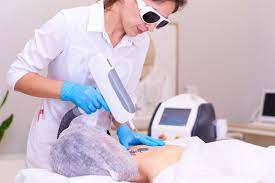Rejuvenate Your Skin: Exploring Laser Fractional Resurfacing Treatments
Posted on: March 23, 2024
Understanding the Procedure’s Benefits
Skin Rejuvenation
Laser fractional resurfacing treatments work wonders for skin texture and tone. They gently remove layers of skin, allowing new, healthy skin to surface. This process significantly enhances the skin’s appearance, making it look fresher and more even.
Patients often notice a vibrant glow and softness they hadn’t seen in years. The procedure targets damaged skin effectively, leaving surrounding areas untouched. This precision encourages faster healing and better results.
Collagen Boost
One key benefit is the reduction of fine lines, wrinkles, and acne scars. The heat from the laser stimulates collagen production beneath the skin. Collagen is crucial for maintaining skin’s elasticity and firmness.
As collagen increases, it fills in lines and scars from within. Over time, this smooths out the skin’s surface, reducing visible signs of aging and damage. Many see significant improvements after just one session.
Quick Recovery
Compared to traditional resurfacing methods, laser fractional resurfacing offers minimal downtime. Patients appreciate being able to return to their daily routines quickly. Most experience only mild redness or swelling for a few days post-treatment.
This convenience makes it an attractive option for those with busy schedules. It eliminates the lengthy recovery periods associated with older techniques.
Identifying Potential Risks
Temporary Effects
Temporary redness, swelling, and itching are common after laser fractional resurfacing treatments. These symptoms typically resolve on their own within a few days to weeks. It’s crucial for patients to follow aftercare instructions closely to aid in the healing process.
Serious Complications
While rare, more serious complications can occur. Infection, scarring, and changes in skin pigmentation pose risks that should not be overlooked. These effects can have lasting impacts on the appearance and health of the skin.
Professional Care
Choosing a qualified professional is essential to minimize risks associated with laser fractional resurfacing treatments. Experienced practitioners can significantly reduce the likelihood of complications by using appropriate techniques and providing comprehensive aftercare guidance.
Preparing for Your Treatment
Sun Protection
Avoiding sun exposure is crucial before undergoing laser fractional resurfacing treatments. Sun-damaged skin can affect the treatment’s effectiveness and increase the risk of complications. Patients should use a high SPF sunscreen and wear protective clothing when outdoors. This precaution is especially important in the weeks leading up to the procedure.
Patients must also refrain from using certain skincare products that may irritate the skin. Products containing retinol, glycolic acid, or other harsh chemicals should be avoided. Consulting with a cosmetic surgeon about an appropriate skincare routine can help prepare the skin for optimal results.
Health Consultation
Discussing current medications and skin conditions with your doctor is essential. Some medications can impact healing times or increase sensitivity to the laser therapy. For instance, patients prone to cold sores may require antiviral medication beforehand to prevent outbreaks.
It’s also vital to disclose any history of skin conditions like eczema or psoriasis, as these could affect treatment outcomes. The appropriate laser settings and techniques are determined based on individual skin tone and condition, ensuring patient satisfaction.
Hydration and Routine
Staying hydrated and maintaining a healthy skin routine are key for preparing your skin for laser treatments. Drinking plenty of water improves skin elasticity and overall health, which can enhance the treatment’s efficacy.
A gentle cleansing regimen that doesn’t strip the skin of its natural oils is recommended. Moisturizing regularly helps maintain the skin’s barrier function, making it more resilient during recovery.
During the Resurfacing Process
Numbing Cream
Before the laser touches your skin, a numbing cream ensures comfort. It’s applied generously over the target area. This step is crucial for a pain-free experience. The cream takes effect, dulling sensations on the face or other areas undergoing treatment.
Patients often report feeling minimal discomfort thanks to this preparation. The sensation is likened to a light snapping against the skin.
Laser Application
The core of this process involves laser technology targeting damaged layers of skin. A precise laser beam moves systematically across the area, removing the outer layer and penetrating deeper to stimulate new collagen production.
This dual action not only removes imperfections like wrinkles and scarring but also encourages the growth of new, healthier skin. The laser system’s precision ensures that only damaged cells are targeted, leaving surrounding tissues unharmed.
Procedure Duration
Typically, sessions last between 30 minutes to an hour. This timeframe allows for thorough coverage of the targeted area without rushing. Patients appreciate knowing their session will be both efficient and effective.
Afterwards, there’s some downtime required for healing. This period varies depending on the individual’s skin type and the extent of their procedure.
What Happens After Treatment
Immediate Care
After undergoing fractional laser treatment, the skin needs tender care. Applying cooling gels or creams is crucial. They soothe the skin and reduce inflammation.
Patients must avoid direct sunlight immediately after treatment. This precaution prevents further skin damage. Using a high SPF sunscreen is non-negotiable when going outdoors.
Recovery Process
The recovery time varies depending on the individual’s skin type and the intensity of the treatment. Initially, patients might experience redness and swelling. These side effects are normal and should subside within a few days.
It’s essential to follow post-treatment instructions closely for optimal healing. Typically, one can resume their regular skincare routine after the skin fully heals, which might take up to one week.
Resuming Activities
Most individuals can return to their daily activities right after treatment. However, strenuous exercises that induce sweating should be avoided for a few days. Sweat can irritate the treated area.
Makeup should be avoided until the skin has healed sufficiently. This period allows the skin to breathe and recover faster.
Anticipating the Results
Visible Improvements
Patients often witness visible improvements within a few weeks post-treatment. This initial change is just the beginning. Skin tone becomes more even, and imperfections start to fade. These early results are promising, but they’re just a preview of what’s to come.
The skin’s natural healing process kicks in, gradually enhancing the effects seen initially. It’s important for patients to be patient as these changes unfold.
Progressive Nature
The progressive nature of laser fractional resurfacing treatments means that results improve over time. As the skin heals, it regenerates new cells that replace older, damaged ones. This regeneration process is crucial for achieving the final outcome.
It works by stimulating collagen production in narrow columns beneath the skin surface. This not only helps in repairing damage but also improves skin elasticity and firmness.
Multiple Sessions
For some, optimal outcomes require more than one session. The number of sessions depends on individual goals and the extent of skin issues being addressed.
Each treatment session builds upon the last, enhancing overall effectiveness. Patients should discuss their goals with a specialist to understand how many sessions might be necessary for them.
Maintenance and Care Post-Procedure
Skincare Regimen
After undergoing laser fractional resurfacing treatments, adopting a tailored skincare routine is crucial. This regimen should focus on hydration and gentle care to support the healing process. Moisturizing products can help soothe the skin, while avoiding harsh chemicals prevents irritation.

It’s important to consult with your skincare professional for personalized advice. They can recommend products that complement your skin type and enhance the procedure’s benefits.
Regular Treatments
For sustained results, regular follow-up sessions may be necessary. These touch-ups help maintain the skin’s improved texture and reduce related scarring over time.
Skincare experts often suggest scheduling these treatments based on individual healing rates and desired outcomes. Adhering to this plan ensures long-lasting improvements and satisfaction with the procedure’s effects.
Lifestyle Factors
Lifestyle choices play a significant role in skin health post-procedure. A balanced diet rich in antioxidants supports skin regeneration. Adequate hydration keeps the skin supple and aids in recovery.
Sun protection is paramount; UV exposure can undermine the treatment’s success and lead to premature aging. Wearing broad-spectrum sunscreen daily, even on cloudy days, provides an essential defense against harmful rays.
Summary
Laser fractional resurfacing treatments offer a transformative approach to skin rejuvenation, balancing benefits and risks. By understanding what to expect before, during, and after your treatment, you’re better equipped to make informed decisions for your skin’s health. Anticipating results and knowing how to maintain them ensures you get the most out of this innovative procedure. Remember, the key to a successful outcome lies in following expert advice for pre-treatment preparation and post-procedure care.
Choosing the right specialist is crucial for achieving desired results while minimizing potential risks. Research, ask questions, and ensure your provider has proven expertise in laser fractional resurfacing. Ready to take the next step towards radiant, youthful skin? Reach out to a trusted professional today and discuss how laser fractional resurfacing can benefit you. Your journey to flawless skin starts now.
Frequently Asked Questions
What are the benefits of laser fractional resurfacing treatments?
Laser fractional resurfacing treatments can significantly improve skin texture, reduce wrinkles, and diminish scars by stimulating collagen production. This leads to healthier, more youthful-looking skin.
Are there any risks associated with laser fractional resurfacing?
Yes, potential risks include temporary redness, swelling, and a rare chance of infection or scarring. However, these risks are minimized when performed by a qualified professional.
How should I prepare for my laser fractional resurfacing treatment?
Avoid sun exposure and refrain from using products containing retinol or glycolic acid for 2 weeks before your treatment. Consult with your specialist for personalized advice.
What can I expect during the laser fractional resurfacing process?
The procedure involves applying a numbing cream to minimize discomfort, followed by the laser treatment which typically lasts between 30 minutes to an hour depending on the area being treated.
What happens after the laser fractional resurfacing treatment?
Post-treatment, you may experience mild redness and swelling for a few days. It’s crucial to follow aftercare instructions like avoiding direct sunlight and applying prescribed creams to aid healing.
When can I anticipate seeing results from my treatment?
Results can be seen as early as one week after treatment, with improvements continuing for up to three months as collagen production increases.
How do I maintain my skin post-procedure?
Maintain your results by following a gentle skincare routine, using sunscreen daily, and possibly scheduling follow-up treatments as advised by your skincare professional.





